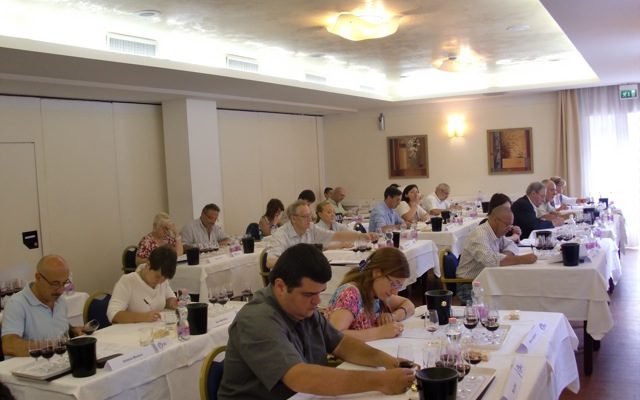Wine competitions: many wineries continue trust them implicitly, especially the international competitions where thousands of wines from around the world are entered. The judges who taste them also come from many different countries. All of the judges are professionals: winemakers, sommeliers, buyers or wine journalists. However, their personal and cultural backgrounds are different. So the question is: is it also possible that their perceptions of wine are different? And it is true that women have an edge over men in tasting wine? For these and other questions concerning the sensory relationship we have with wine, we may find some answers in a science increasingly widespread in the world of wine: sensory analysis.
I recently spoke with international expert Luigi Odello. In addition to being a winemaker, science writer and lecturer, for the past 20 years he has also served as CEO of the Centro Studi Assaggiatori in Brescia (Italy), a leading research center for sensory analysis, which also offers intense training for students and professionals.

What is the difference between “to taste” and “to perform sensory analysis” of a wine? Can we say that the tasting is an art, and sensory analysis a science?
Yes, we can say so because it is true, at least in part. Ordinarily, tasting a wine implies an emotional involvement; it may have no precise rules and its goal may simply be enjoyment for those involved.
However, even in sensory analysis we have an emotional involvement, and we can also enjoy the wine itself. But the goals are a bit different because this discipline tries to give a scientific answer to specific questions (i.e., quantifying how much a product is preferred, or enumerating the existence of the difference between two or more products) and therefore is subject to the rules of metrology. Thus, when you do a test of sensory analysis, you collect a series of data which we need to develop in order to first understand the level of trust, reliability and completeness of the test itself.
Is it true that as we age, our sensory capacities decrease?
From our experience, we can say that as a person gets older, the difference between individuals is emphasized. It’s enough to say that currently our panel has several very reliable members who are 70.”
Are you saying that it’s possible to fight the decay of our senses?
Of course, with training. We believe that older people use experience to compensate for any reduction of their senses. And this helps them to live better, too, because an active sense of smell makes them feel safer and more calm. So my advice is: if you want to live a better life, seek the pleasure of smell. And wine is a great product to smell!
What are the most common beliefs – and the most common incorrect ideas – about sensory analysis as applied to wine?
In the world of food, wine is almost an event in itself, in which the producer feels himself or herself to be like an artist, and so he or she believes they alone can judge and value their product. But would they drink it all themselves, because the rest of the world has different tastes? I exaggerate, of course. But the first misconception is that a wine can be evaluated only by technically-knowledgeable people like sommeliers or winemakers. In sensory analysis this is not so: a judge is chosen depending on the objective of the test. Our tool is the judge, and the judges we choose depend largely on the goal we want to achieve.
It is often said that women are better tasters than men. Is this true?
Yes, women can be excellent judges, because they are more focused on details, and generally their sense of smell tends to be above average.
Your center is organizing courses in sensory analysis all around the world; have you noticed a different cultural approach to the wine in different countries?
To change the culture is to change the feeling about wine: what for an Italian person is sweet, for an American is less sweet, and for an Asian is cloying.
Japanese people work incredibly well at channeling kinesthetic elements: in olfactory analysis, touch and taste they are fantastic.
On the other hand, Brazilians have great difficulty expressing what they are perceiving; the result is that their training in expressing a free, personal description of a wine takes longer.
Russians love strong perceptions, and so they decide to focus mostly on those. For the Chinese people, the only wine is red; white wine is never “wine” enough! Yet, they hate the astringency… And so on. These are just a few examples.
People are saying it’s time to rethink the vocabulary of terms for describing wine, because the sensory experience varies, depending on the culture; do you agree?
Yes, I think that’s true. We should rethink the vocabulary, especially in countries with a long tradition of wine, like Europe. For a wine insiders, the word “aristocratic” denotes a fine wine, but for the consumer – especially a “new wine lover” – the use of this term can evoke an unfriendly and arrogant product, and because of this it would be unlikeable.
Is it possible to apply sensory analysis to an existing object? For example, a winery?
Definitely yes. And not just a winery, but any public space: a wine bar, a restaurant, a hairdressing salon, or a point of sale of modern distribution. And today, with the increase in wine tourism, this approach is very useful because it allows you to perfect your storytelling of wine, making it more interesting and appropriate to your audience. Furthermore this analysis is inexpensive, thus affordable for everyone.
What practical advice can you give to a novice wine enthusiast visiting a winery for the first time?
The first winery, like the first love, you never forget it. Everything is new, attractive, engaging. This experience is like a revealed secret. The problems come later, with the second, third…and yet another visit to a winery, where, unfortunately, still too often you hear always the same thing: often self-celebrative, without a hint of empathy for you or the group of visitors. This kind of monotony is not only typical of wineries, but also of many wine writers and wine testimonials. I think that wine communication, at this moment, is the area that needs more innovation. But it will be possible only if we perform an act of humility and get off the stage, to mingle with our readers and listeners.
[author] [author_image timthumb=’on’]http://palatepress.com/wp-content/uploads/2010/02/162f729-e1266674226608.jpg[/author_image] [author_info]Elisabetta Tosi is a freelance wine journalist and wine blogger. She lives in Valpolicella, where the famous red wines Amarone, Ripasso, and Recioto are produced. Professionally, she serves as a web-consultant for wineries, and in her free time writes books about Italian wines. She is also a contributor to Vino Pigro.[/author_info] [/author]

